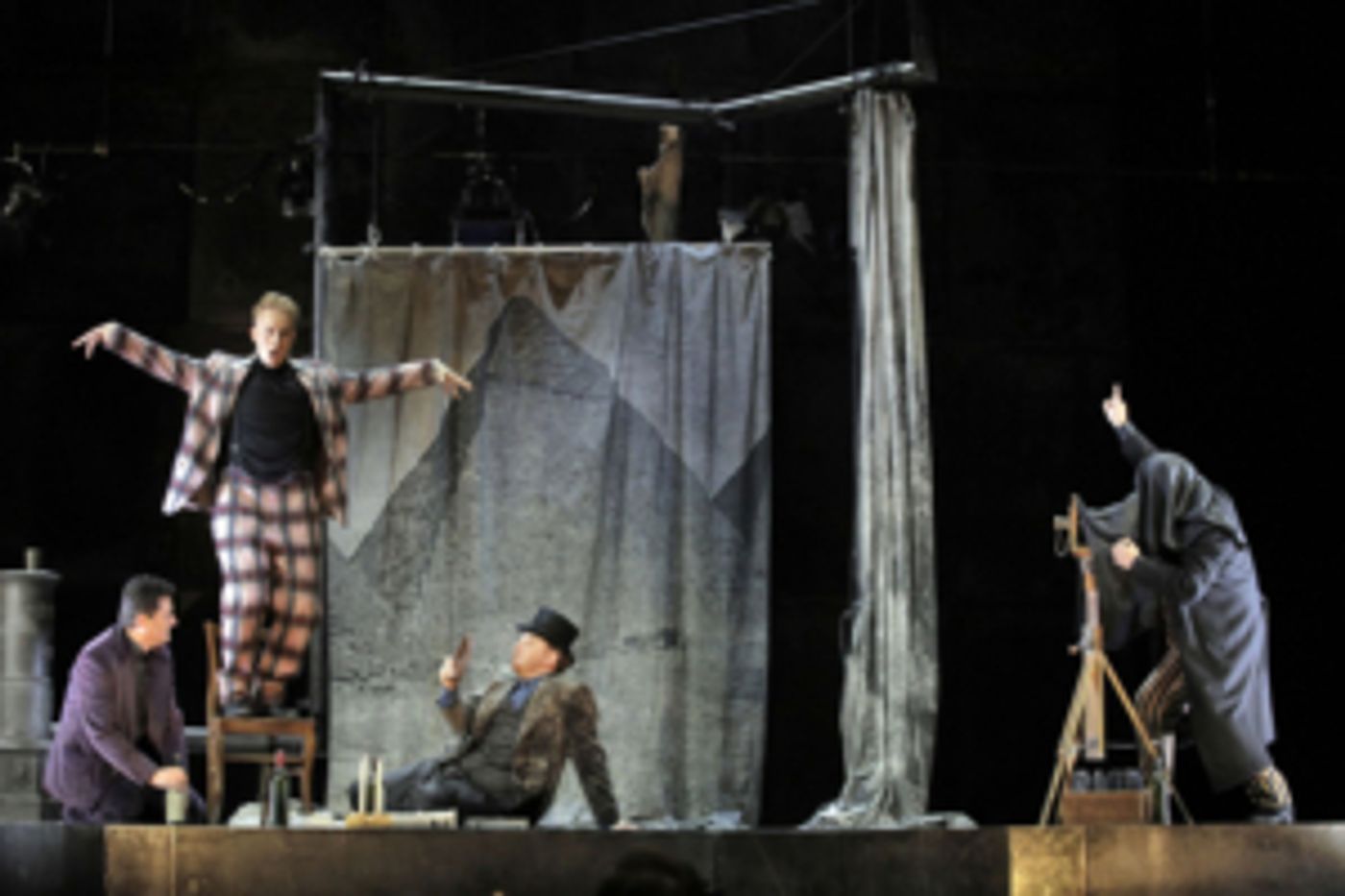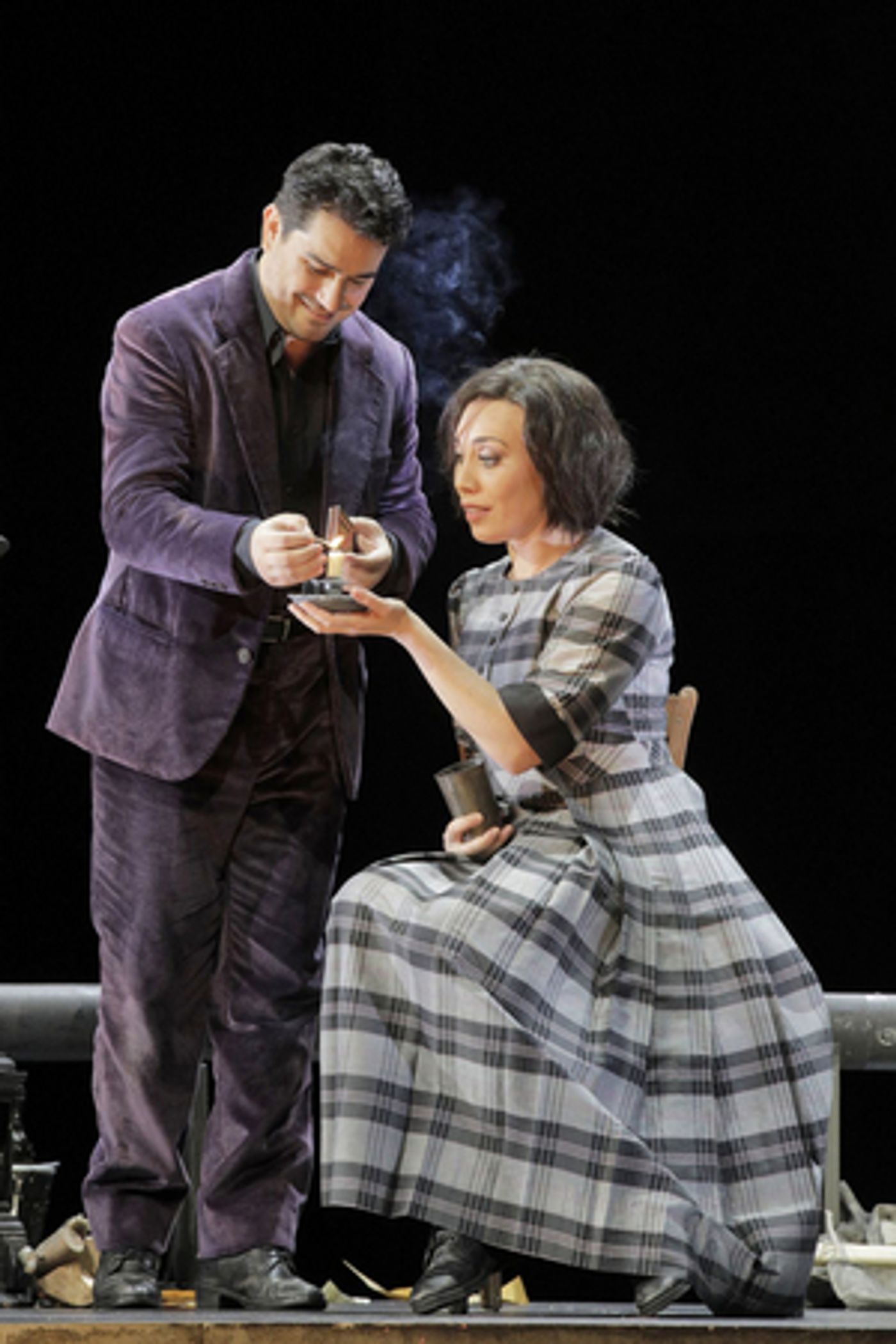Review: LA BOHEME at Dorothy Chandler Pavilion

 Los Angeles Opera opened its 2019-2020 season with Barrie Kosky's production of that most popular of operas, Giacomo Puccini's LA BOHEME. With minimal scenery from Rufus Didwiszus, Kosky's cast made the audience believe they were in the garret and at the toll gate. Only the scenery for the Café Momus was completely fleshed out. The entry to Didwiszus' garret was through a trap door in the center of the room which contained a stove, a nineteenth century camera, and a huge canvas drape for Marcello's Red Sea painting, but no couch or table.
Los Angeles Opera opened its 2019-2020 season with Barrie Kosky's production of that most popular of operas, Giacomo Puccini's LA BOHEME. With minimal scenery from Rufus Didwiszus, Kosky's cast made the audience believe they were in the garret and at the toll gate. Only the scenery for the Café Momus was completely fleshed out. The entry to Didwiszus' garret was through a trap door in the center of the room which contained a stove, a nineteenth century camera, and a huge canvas drape for Marcello's Red Sea painting, but no couch or table.
Act II had streetlights, tables, and chairs which accommodated hundreds of choristers and supers who provided a lively and celebratory Christmas Eve. The Act III scene was set by a hanging depicting a somewhat blurred gray building. The hanging was slit so that characters could enter and exit upstage center. Since Act IV presented the same minimal garret, Mimi died sitting in a chair with only the bowing of her head to denote her passing. With minimal scenery, Alessandro Carletti's lighting design added a great deal of interest to the total stage picture.
Victoria Behr's costumes showed the spirit if not the exact patterns of the 1840s, the time in which the opera is set. Mimi wore soft, dark colors and Musetta lighter, brighter shades. Marcello sported a rust and black striped suit. Schaunard's outfit was plaid while the other men were conservatively dressed. Colline's mock-rabbit coat lacked extra pockets for his books.
Saimir Pirgu has been a fine tenor for a several years now, but tonight he outdid himself. His mid-sized voice filled the Chandler Pavilion with waves of opulent sound couched in elegant diction. His Rodolfo was young, ardent, and fun-loving but with an innate refinement of both sound and gesture. His "Che gelida manina" ("What an icy little hand") and "O soave fanciulla" ("O Lovely Girl") were enticing and I imagine every woman in the audience wished those arias were being sung to her. Although Pirgu was born in Albania, his musical style and diction are exquisitely Italian.
Marina Costa-Jackson was a totally believable Mimi who grabbed the audience's sympathy the moment she walked on stage. Her voice is soft grained and rests easy on the ears. It is her acting and interpretation that distinguish her artistry, however. She was deeply in character for every moment of her intense portrayal and she gave a fully detailed characterization of the consumptive young French woman. She and Pirgu had tremendous chemistry together throughout the entire opera and one could almost see sparks fly out from their embraces.
Kihun Yoon's sturdy, bronze-voiced Marcello was the perfect foil for Pirgu's Rodolfo. His legato was smooth while his forte was strong and virile. Together, the two young men rough-housed and played at fighting, but onlookers could see their true affection for each other. Yoon's Marcello was understanding with Mimi but insanely jealous of Musetta's relationships with men other than himself.
When the audience first meets Musetta, she is having a bad day. Her elderly sugar-daddy is tiring of her temper and people are not giving her all the attention she needs to feel secure. Her "Quando m'en vo" ("When I Go Along") described her life as she saw it. Kosky's mise-en-scène made the audience realize that she was not quite as popular as she imagined. Erica Petrocelli's vocal artistry was seductive, however, and she won over not only Marcello, but the audience as well. Her exchanges with Marcello in Act III had a realistic edge to them because both characters were in pain. Her Act IV prayer was beautiful in its straight forward simplicity and it signified her acceptance of the tragedy of reality.
As Schaunard, Michael J. Hawk's energetic stage personality made him the most fun-loving of the men and his light vocal timbre added contrast to the ensembles. Bass-baritone Nicholas Brownlee's honeyed tones added both earthiness and polish to his rendition of "Vecchia Zimarra" ("Old Overcoat"). Patrick Blackwell represented two totally different characters: Benoit, the wine-loving landlord, and Alcindoro, the old man who wants a young beauty on his arm. Reid Bruton as the Custom House Officer and Steve Pence as the Sergeant added to the realism of Act III. Chorus Director Grant Gershon's Opera Chorus and Fernando Malvar-Ruiz's Children's Chorus worked together to make Act II a perfect respite from tragedy.
The orchestra's sound was glorious, some passages translucent and others romantically blended. One of Los Angeles Opera's greatest assets is Conductor James Conlon who played with well thought out rubato and drew both lyric and dramatic virtuosity from his instrumental artists. This was a performance to be savored and its audience rewarded the performers with thunderous applause at its end. In the final moments before the curtain came down, Conlon brought all his players on stage so that they, too, could enjoy the audience's response to their work. Los Angeles Opera's fascinating La Boheme can be seen at the Dorothy Chandler Pavilion until October 6th.
Photos by Cory Weaver for LA Opera
Reader Reviews

Videos

